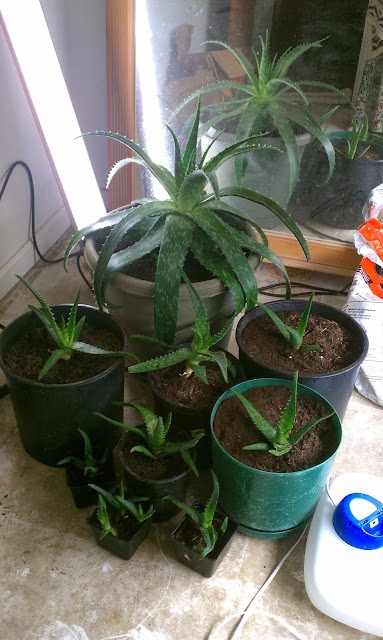Thursday, December 26, 2013
Five Days After Transplant
The newly transplanted Aloe pups are doing well five days later, showing only mild shock compared to their first transplant of being separated from the mother plant. The smallest of the pups have showed symptoms of stunted growth, their small root systems still need to develop greatly. Overall color remains green with no yellowing; older leaves have softened slightly. The larger pups remain healthy, staying light green in the center with new growth. Vigor has slowed little with mild discoloration and soft spots in the center of older leaves spreading outward. Below is one of the larger pups that is undergoing a great amount of stress; showing the most discoloration on older leaves- turning soft and dark green. It will most likely be another one to two weeks before normal health and vigor resume.
Saturday, December 21, 2013
Second Transplant of Class One Aloe Clusters
 |
| Before Transplant |
 |
| After Transplant |
 |
| Figure 1. |
 |
| Seperated Aloe clusters; minimal root damage |
~Gabby
The Green Project 2013
Thursday, December 19, 2013
Aloe Vera Greenhouse: The Beginning
 |
| Mother Plant |
 |
| Dried Aloe Vera Stalk off of Mother Plant |
Below: image of all transplanted "pups" with mother plant; with the exception of two small pups still attached to the mother plant
The nursery can be divided into three main classes based on size and maturity:
 |
| Class 1 |
 |
| Class 2 |
Class three is reserved for sexually mature plants. Currently the only adult plant in the nursery is the mother.
The plant circled in red is un-categorized, it is too large to be placed in class one and too small to be placed in class too. Its rate of growth and development will determine which class it is later placed in. This categorization based on size will later prove helpful when it comes time to begin fertilization.
~Gabby
The Green Project 2013
Wednesday, December 18, 2013
What You Didn't Know About Aloe Vera
The use of Aloe Vera can be traced back as far as 6,000 years ago. The plant has been found depicted on stone carvings originating from early Egypt where it was known as "the plant of immorality". Some of the many uses of Aloe Vera include:
Enzymes (helps digestion by breaking down fats and sugars)
- topically for various skin conditions and to heal wounds
- orally as a laxative
- treatment of diabetes
- asthma
- epilepsy
- osteoarthritis
- burns
- sunburns
- psoriasis
- moisturizer
- Vitamin A
- Vitamin C
- Vitamin E
- Vitamin B12 (important vitamin for vegetarians/vegans)
- bradykinase-reduces excessive inflamation, thus reducing pain when applied to the skin topically
- lipases and proteases-assists in digestive breakdown of foods
- some other enzymes can help digest dead tissues in wounds
Essential Minerals
- Calcium
- Sodium Potassium
- Manganese
- Magnesium
- Copper
- Zinc
- Chromium
- The Antioxidant Selenium
Sugars
Aloe contains sugars known as mucopolysaccharides. These sugars are derived from the Mucilage layer of the leaf that surrounds the inner gel.
They enhance the immune system and help detoxify, thus bringing great benefits to one's health.
Saponins
Saponins are soapy substances, forming about 3% of the Aloe Vera gel. They posses cleaning and antiseptic properties containing antimicrobials that prove powerful against bacteria, viruses, fungi, and yeasts.
Fatty Acids
- Cholesterol
- Campesterol
- Sisosterol
- Lupeol
Salicylic Acid
aspirin like compound that has anti inflammatory and anti bacterial properties (salicylic acid can be found in most over the counter acne treatments and washes)
Amino Acids
Aloe Vera gel contains 20 of the 22 amino acids our body needs.
In addition, out of the 8 amino acids our body cannot synthesize, Aloe Vera provides 7.
Disclaimer: Each individual considering Alternative medicine should research further information and exercise caution. As always-moderation is key with everything.
~Gabby
The Green Project 2013
The Green Project 2013
The Green Project is the beginning of an experimental entrepreneurship that will follow me throughout college as I apply what I already know to what I will learn as a student of Texas Tech University. In Spring of 2014 I will officially begin my freshman year of college as a distance student. I chose to complete my Bachelor of Science in Horticulture online as a distance student for one specific reason: the ability to earn college credit while experiencing first hand the different flora nonnative to the United States mainland. I will be documenting these rare opportunities as well as the progression of my Aloe Vera Nursery. As a student of TTU I will always have to return to Texas periodically throughout the year to take exams, complete labs, and participate in hands on work in the garden (such as pruning technique); but I will still have enough freedom to travel over long periods of time. Through this project I hope to increase my chances for scholarships and gain hands on experience relative to an internship; with some luck and TLC I may even profit from my nursery by learning how to make homemade organic products, a great resource to fuel my college fund and further help me reach my goal of obtaining my Master's Degree.
~Gabby
The Green Project 2013
Subscribe to:
Comments (Atom)



